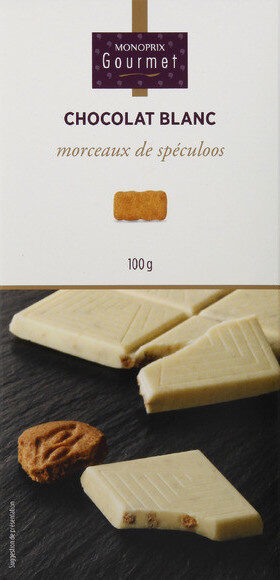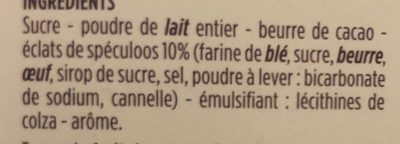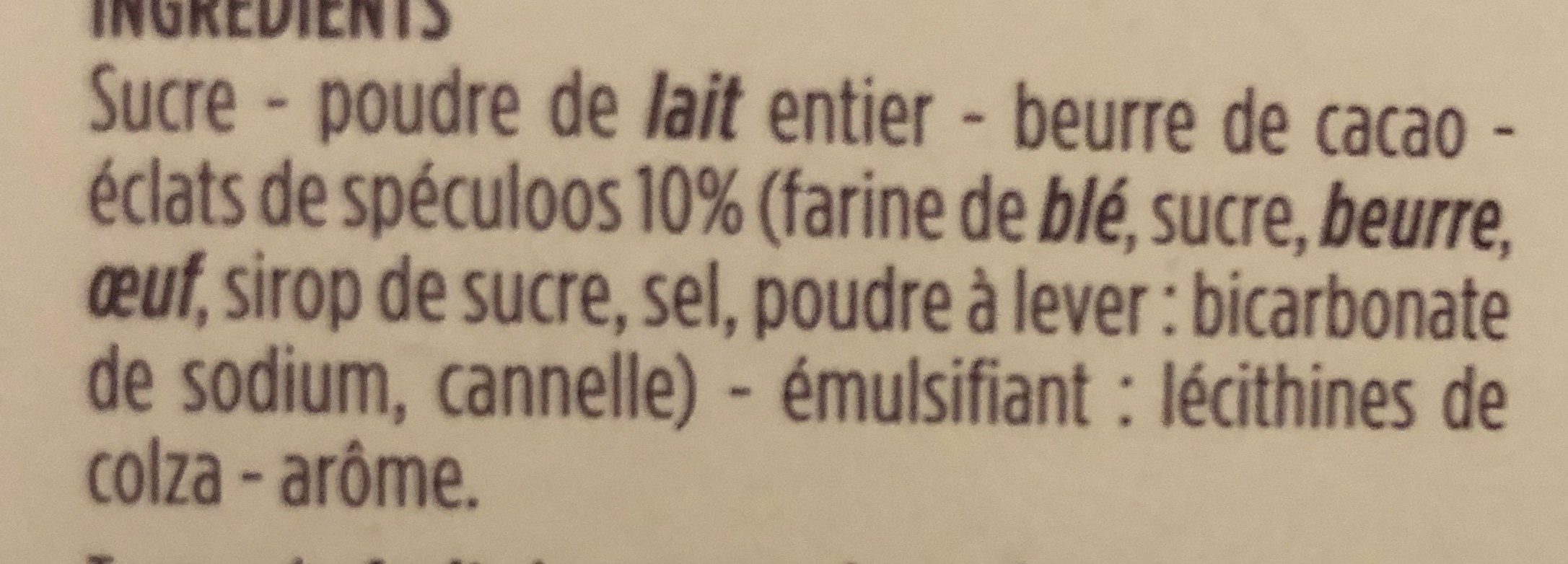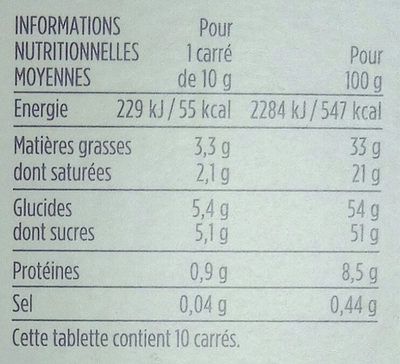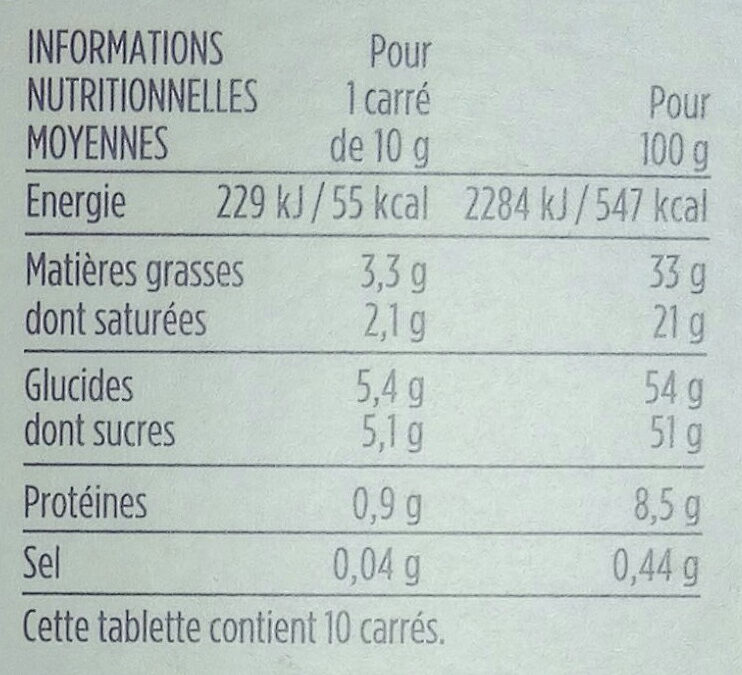帮助我们让食品信息的透明度称为所有人的标准!
作为一个非营利性机构,我们需要依靠您的捐款才能继续向世界各地的消费者报告有关他们食品的信息。
视频革命从你开始!
Chocolat blanc morceaux de speculoos - Monoprix Gourmet - 100 g
Chocolat blanc morceaux de speculoos - Monoprix Gourmet - 100 g
条形码: 3350033103351 (EAN / EAN-13)
数量: 100 g
包装: en:Recycle, fr:Feuille métal, fr:Étui carton
品牌: Monoprix Gourmet
分类: 零食, 含糖零食, en:Cocoa and its products, 巧克力, 白巧克力, fr:Chocolats blancs au speculoos
标签,认证,奖励:
Fair trade, Fairtrade International, Max Havelaar, Triman


溯源代码: EMB 42218J - Saint-Étienne (Loire, France)
商店: Monoprix
匹配您的喜好
健康
成分
-
16 种成分
法语: Sucre - poudre de lait entier - beurre de cacao - éclats de spéculoos 10% (farine de blé, sucre, beurre, œuf, sirop de sucre, sel, poudre à lever: bicarbonate de sodium, cannelle) - émulsifiant : lécithines de colza - arôme. Traces de fruits à coque, soja et sésame. Les informations en gras sont destinées aux personnes intolérantes ou allergiques.过敏原: 雞蛋, 麸质, 乳跟踪: 坚果, 芝麻, 大豆类制品
食品加工
-
超级加工食品
指示产品在 4 - 超加工食品和饮料产品 类中的元素:
- 添加剂: E322
- 成分: Emulsifier
- 成分: 调味剂
添加剂
-
E322
Lecithin: Lecithin -UK: , US: , from the Greek lekithos, "egg yolk"- is a generic term to designate any group of yellow-brownish fatty substances occurring in animal and plant tissues, which are amphiphilic – they attract both water and fatty substances -and so are both hydrophilic and lipophilic-, and are used for smoothing food textures, dissolving powders -emulsifying-, homogenizing liquid mixtures, and repelling sticking materials.Lecithins are mixtures of glycerophospholipids including phosphatidylcholine, phosphatidylethanolamine, phosphatidylinositol, phosphatidylserine, and phosphatidic acid.Lecithin was first isolated in 1845 by the French chemist and pharmacist Theodore Gobley. In 1850, he named the phosphatidylcholine lécithine. Gobley originally isolated lecithin from egg yolk—λέκιθος lekithos is "egg yolk" in Ancient Greek—and established the complete chemical formula of phosphatidylcholine in 1874; in between, he had demonstrated the presence of lecithin in a variety of biological matters, including venous blood, in human lungs, bile, human brain tissue, fish eggs, fish roe, and chicken and sheep brain. Lecithin can easily be extracted chemically using solvents such as hexane, ethanol, acetone, petroleum ether, benzene, etc., or extraction can be done mechanically. It is usually available from sources such as soybeans, eggs, milk, marine sources, rapeseed, cottonseed, and sunflower. It has low solubility in water, but is an excellent emulsifier. In aqueous solution, its phospholipids can form either liposomes, bilayer sheets, micelles, or lamellar structures, depending on hydration and temperature. This results in a type of surfactant that usually is classified as amphipathic. Lecithin is sold as a food additive and dietary supplement. In cooking, it is sometimes used as an emulsifier and to prevent sticking, for example in nonstick cooking spray.来源: Wikipedia (英语)
-
E322i - 卵磷脂
Lecithin: Lecithin -UK: , US: , from the Greek lekithos, "egg yolk"- is a generic term to designate any group of yellow-brownish fatty substances occurring in animal and plant tissues, which are amphiphilic – they attract both water and fatty substances -and so are both hydrophilic and lipophilic-, and are used for smoothing food textures, dissolving powders -emulsifying-, homogenizing liquid mixtures, and repelling sticking materials.Lecithins are mixtures of glycerophospholipids including phosphatidylcholine, phosphatidylethanolamine, phosphatidylinositol, phosphatidylserine, and phosphatidic acid.Lecithin was first isolated in 1845 by the French chemist and pharmacist Theodore Gobley. In 1850, he named the phosphatidylcholine lécithine. Gobley originally isolated lecithin from egg yolk—λέκιθος lekithos is "egg yolk" in Ancient Greek—and established the complete chemical formula of phosphatidylcholine in 1874; in between, he had demonstrated the presence of lecithin in a variety of biological matters, including venous blood, in human lungs, bile, human brain tissue, fish eggs, fish roe, and chicken and sheep brain. Lecithin can easily be extracted chemically using solvents such as hexane, ethanol, acetone, petroleum ether, benzene, etc., or extraction can be done mechanically. It is usually available from sources such as soybeans, eggs, milk, marine sources, rapeseed, cottonseed, and sunflower. It has low solubility in water, but is an excellent emulsifier. In aqueous solution, its phospholipids can form either liposomes, bilayer sheets, micelles, or lamellar structures, depending on hydration and temperature. This results in a type of surfactant that usually is classified as amphipathic. Lecithin is sold as a food additive and dietary supplement. In cooking, it is sometimes used as an emulsifier and to prevent sticking, for example in nonstick cooking spray.来源: Wikipedia (英语)
-
E500
Sodium carbonate: Sodium carbonate, Na2CO3, -also known as washing soda, soda ash and soda crystals, and in the monohydrate form as crystal carbonate- is the water-soluble sodium salt of carbonic acid. It most commonly occurs as a crystalline decahydrate, which readily effloresces to form a white powder, the monohydrate. Pure sodium carbonate is a white, odorless powder that is hygroscopic -absorbs moisture from the air-. It has a strongly alkaline taste, and forms a moderately basic solution in water. Sodium carbonate is well known domestically for its everyday use as a water softener. Historically it was extracted from the ashes of plants growing in sodium-rich soils, such as vegetation from the Middle East, kelp from Scotland and seaweed from Spain. Because the ashes of these sodium-rich plants were noticeably different from ashes of timber -used to create potash-, they became known as "soda ash". It is synthetically produced in large quantities from salt -sodium chloride- and limestone by a method known as the Solvay process. The manufacture of glass is one of the most important uses of sodium carbonate. Sodium carbonate acts as a flux for silica, lowering the melting point of the mixture to something achievable without special materials. This "soda glass" is mildly water-soluble, so some calcium carbonate is added to the melt mixture to make the glass produced insoluble. This type of glass is known as soda lime glass: "soda" for the sodium carbonate and "lime" for the calcium carbonate. Soda lime glass has been the most common form of glass for centuries. Sodium carbonate is also used as a relatively strong base in various settings. For example, it is used as a pH regulator to maintain stable alkaline conditions necessary for the action of the majority of photographic film developing agents. It acts as an alkali because when dissolved in water, it dissociates into the weak acid: carbonic acid and the strong alkali: sodium hydroxide. This gives sodium carbonate in solution the ability to attack metals such as aluminium with the release of hydrogen gas.It is a common additive in swimming pools used to raise the pH which can be lowered by chlorine tablets and other additives which contain acids. In cooking, it is sometimes used in place of sodium hydroxide for lyeing, especially with German pretzels and lye rolls. These dishes are treated with a solution of an alkaline substance to change the pH of the surface of the food and improve browning. In taxidermy, sodium carbonate added to boiling water will remove flesh from the bones of animal carcasses for trophy mounting or educational display. In chemistry, it is often used as an electrolyte. Electrolytes are usually salt-based, and sodium carbonate acts as a very good conductor in the process of electrolysis. In addition, unlike chloride ions, which form chlorine gas, carbonate ions are not corrosive to the anodes. It is also used as a primary standard for acid-base titrations because it is solid and air-stable, making it easy to weigh accurately.来源: Wikipedia (英语)
-
E500ii - 碳酸氢钠
Sodium carbonate: Sodium carbonate, Na2CO3, -also known as washing soda, soda ash and soda crystals, and in the monohydrate form as crystal carbonate- is the water-soluble sodium salt of carbonic acid. It most commonly occurs as a crystalline decahydrate, which readily effloresces to form a white powder, the monohydrate. Pure sodium carbonate is a white, odorless powder that is hygroscopic -absorbs moisture from the air-. It has a strongly alkaline taste, and forms a moderately basic solution in water. Sodium carbonate is well known domestically for its everyday use as a water softener. Historically it was extracted from the ashes of plants growing in sodium-rich soils, such as vegetation from the Middle East, kelp from Scotland and seaweed from Spain. Because the ashes of these sodium-rich plants were noticeably different from ashes of timber -used to create potash-, they became known as "soda ash". It is synthetically produced in large quantities from salt -sodium chloride- and limestone by a method known as the Solvay process. The manufacture of glass is one of the most important uses of sodium carbonate. Sodium carbonate acts as a flux for silica, lowering the melting point of the mixture to something achievable without special materials. This "soda glass" is mildly water-soluble, so some calcium carbonate is added to the melt mixture to make the glass produced insoluble. This type of glass is known as soda lime glass: "soda" for the sodium carbonate and "lime" for the calcium carbonate. Soda lime glass has been the most common form of glass for centuries. Sodium carbonate is also used as a relatively strong base in various settings. For example, it is used as a pH regulator to maintain stable alkaline conditions necessary for the action of the majority of photographic film developing agents. It acts as an alkali because when dissolved in water, it dissociates into the weak acid: carbonic acid and the strong alkali: sodium hydroxide. This gives sodium carbonate in solution the ability to attack metals such as aluminium with the release of hydrogen gas.It is a common additive in swimming pools used to raise the pH which can be lowered by chlorine tablets and other additives which contain acids. In cooking, it is sometimes used in place of sodium hydroxide for lyeing, especially with German pretzels and lye rolls. These dishes are treated with a solution of an alkaline substance to change the pH of the surface of the food and improve browning. In taxidermy, sodium carbonate added to boiling water will remove flesh from the bones of animal carcasses for trophy mounting or educational display. In chemistry, it is often used as an electrolyte. Electrolytes are usually salt-based, and sodium carbonate acts as a very good conductor in the process of electrolysis. In addition, unlike chloride ions, which form chlorine gas, carbonate ions are not corrosive to the anodes. It is also used as a primary standard for acid-base titrations because it is solid and air-stable, making it easy to weigh accurately.来源: Wikipedia (英语)
分析成分
-
en:Palm oil free
未检测到含有棕榈油的配料
-
非素食
非素食配料: en:Whole milk powder, 黄油, 雞蛋
-
en:Vegetarian status unknown
无法识别的配料: en:Speculoos
-
成分分析的详细信息
fr: Sucre, poudre de lait entier, beurre de cacao, spéculoos 10% (farine de blé, sucre, beurre, œuf, sirop de sucre, sel, poudre à lever (bicarbonate de sodium), cannelle), émulsifiant (lécithines de colza), arôme- Sucre -> en:sugar - vegan: yes - vegetarian: yes - ciqual_proxy_food_code: 31016 - percent_min: 16.6666666666667 - percent_max: 70
- poudre de lait entier -> en:whole-milk-powder - vegan: no - vegetarian: yes - ciqual_food_code: 19021 - percent_min: 10 - percent_max: 40
- beurre de cacao -> en:cocoa-butter - vegan: yes - vegetarian: yes - ciqual_food_code: 16030 - percent_min: 10 - percent_max: 30
- spéculoos -> en:speculoos - ciqual_food_code: 24000 - percent_min: 10 - percent: 10 - percent_max: 10
- farine de blé -> en:wheat-flour - vegan: yes - vegetarian: yes - ciqual_proxy_food_code: 9410 - percent_min: 1.25 - percent_max: 10
- sucre -> en:sugar - vegan: yes - vegetarian: yes - ciqual_proxy_food_code: 31016 - percent_min: 0 - percent_max: 5
- beurre -> en:butter - vegan: no - vegetarian: yes - ciqual_proxy_food_code: 16400 - percent_min: 0 - percent_max: 3.33333333333333
- œuf -> en:egg - vegan: no - vegetarian: yes - ciqual_food_code: 22000 - percent_min: 0 - percent_max: 2.5
- sirop de sucre -> en:sugar-syrup - vegan: yes - vegetarian: yes - percent_min: 0 - percent_max: 2
- sel -> en:salt - vegan: yes - vegetarian: yes - ciqual_food_code: 11058 - percent_min: 0 - percent_max: 0.44
- poudre à lever -> en:raising-agent - percent_min: 0 - percent_max: 0.44
- bicarbonate de sodium -> en:e500ii - vegan: yes - vegetarian: yes - percent_min: 0 - percent_max: 0.44
- cannelle -> en:cinnamon - vegan: yes - vegetarian: yes - percent_min: 0 - percent_max: 0.44
- émulsifiant -> en:emulsifier - percent_min: 0 - percent_max: 10
- lécithines de colza -> en:rapeseed-lecithin - vegan: yes - vegetarian: yes - percent_min: 0 - percent_max: 10
- arôme -> en:flavouring - vegan: maybe - vegetarian: maybe - percent_min: 0 - percent_max: 5
营养
-
营养质量不好
⚠ ️警告:未指定纤维数量,它们对营养等级可能的正向贡献或许不被考虑在内。⚠ ️警告:标签上没有注明水果、蔬菜和坚果的含量,它是根据配料表估计的: 0在计算营养分数时,产品是否不被认为是饮料
积极点: 0
- 蛋白质: 5 / 5 (值: 8.5, 四舍五入值: 8.5)
- 纤维: 0 / 5 (值: 0, 四舍五入值: 0)
- 水果,蔬菜,坚果,油菜/核桃/橄榄油: 0 / 5 (值: 0, 四舍五入值: 0)
消极点: 27
- 能量: 6 / 10 (值: 2289, 四舍五入值: 2289)
- 糖: 10 / 10 (值: 51, 四舍五入值: 51)
- 饱和脂肪: 10 / 10 (值: 21, 四舍五入值: 21)
- 钠: 1 / 10 (值: 176, 四舍五入值: 176)
蛋白质的分数不计算,因为负的分数大于或等于11。
营养评分: (27 - 0)
营养分数:
-
营养水平
-
脂肪在最高含量中 (33%)
您需要了解的内容- 大量摄入脂肪,尤其是饱和脂肪,会升高胆固醇,从而增加患心脏病的风险。
推荐: 减少脂肪和饱和脂肪的摄入- 选择脂肪和饱和脂肪含量较低的产品。
-
饱和脂肪在最高含量中 (21%)
您需要了解的内容- 大量摄入脂肪,尤其是饱和脂肪,会升高胆固醇,从而增加患心脏病的风险。
推荐: 减少脂肪和饱和脂肪的摄入- 选择脂肪和饱和脂肪含量较低的产品。
-
糖在最高含量中 (51%)
您需要了解的内容- 大量摄入糖类会导致体重增加和诱发蛀牙。它还会增加患 2 型糖尿病和心血管疾病的风险。
推荐: 限制食糖和含糖饮料的消费- 应尽可能限制含糖饮料(如苏打水、果汁饮料、果汁和蜂蜜)的饮用(每天不超过 1 杯)。
- 选择含糖量较低的产品,减少含糖产品的消费。
-
食盐在中等数量中 (0.44%)
您需要了解的内容- 大量摄入盐(或钠)会导致高血压,从而增加患心脏病和中风的几率。
- 因为通常没有症状,很多高血压患者并不知道自己患有高血压。
- 大多数人摄入过多的盐(平均每天 9 至 12 克),约是建议最大摄入量的两倍。
推荐: 控制盐和腌制类食物的摄入- 减少烹饪时盐的用量,也不要在吃饭时再次加盐。
- 限制咸味零食的食用,并选择含盐量较低的产品。
-
-
营养成分
营养成分 已售出的
对于 100 克 / 100 毫升与它比较:: 巧克力 蛋白质 8.5 g +18% 脂肪 33 g -8% 饱和脂肪 21 g +6% 碳水化合物 54 g +17% 糖 51 g +27% 食盐 0.44 g +159%
环境影响
-
生态得分 C - 中度的环境影响
⚠ ️交通运输对贵国的全面影响目前尚不清楚。Eco-Score 是实验分数,用于总结食品对环境的影响。→ Eco-Score 最初适用于法国,随后推广到欧洲其他国家。Eco-Score 计算公式会定期更新改进,以提高在各个国家的适应性和精确性。生命周期分析
-
同类产品的平均影响值: D (Score: 39/100)
分类: White chocolate bar
- PEF 环境评分: 0.76 (分数越低,影响越小)
- 包括对气候变化的影响: 11.32 千克二氧化碳当量/千克产品
阶段 影响 农业
58.5 %加工
35.4 %包装
1.4 %运输
4.1 %分派
0.6 %消耗量
0.0 %
加分与减分
-
标签具有环境效益
加分: +10
-
Fairtrade International
Fair trade is an arrangement designed to help producers in developing countries achieve sustainable and equitable trade relationships. Members of the fair trade movement add the payment of higher prices to exporters, as well as improved social and environmental standards.
-
-
包装具有低度影响
减分: -2
形状 材料 循坏利用 影响 Sheet Metal Recycle 高 Sleeve Cardboard 低 ⚠ ️ 此产品的包装信息不够精确 (包装所有组成部分的形状和材料)。
此产品的 Eco-Score
-
对本产品的影响: C (Score: 42/100)
产品: Chocolat blanc morceaux de speculoos - Monoprix Gourmet - 100 g
生命周期分析得分: 39
加分与减分的总和: +8
最终得分:: 42/100
-
碳足迹
-
等于汽油汽车行驶 5.9 公里
每 100 克产品含 1132 g CO²
碳排放数据来自ADEME的 Agribalyse 数据库,其类别如下: White chocolate bar (资料来源:ADEME Agribalyse Database)
阶段 影响 农业
46.4 %加工
49.6 %包装
0.9 %运输
2.9 %分派
0.2 %消耗量
0.0 %
包装
运输
-
成分来源
缺少成分来源信息
添加该产品成分的来源 添加该产品成分的来源
标签
-
Fairtrade International
Fair trade is an arrangement designed to help producers in developing countries achieve sustainable and equitable trade relationships. Members of the fair trade movement add the payment of higher prices to exporters, as well as improved social and environmental standards.
Report a problem
-
Incomplete or incorrect information?
Category, labels, ingredients, allergens, nutritional information, photos etc.
If the information does not match the information on the packaging, please complete or correct it. Open Food Facts is a collaborative database, and every contribution is useful for all.
数据来源
添加产品 由 openfoodfacts-contributors
上次修改产品页面时间 由 mariacastiel.
产品页面已被修改 camillem, clbclb, kiliweb, moon-rabbit, packbot, tacite, teolemon.
最近一次修改产品页面在... 由 moon-rabbit.

